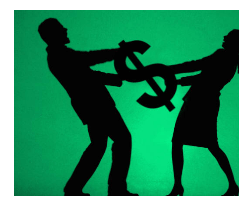 It’s a normal day at the office. I’m working on a few cases and an email comes across from a manager at one of my stores. There’s not much to it; just says “John” called the store looking for you, here’s his number. Curious to who John is, I immediately give him a call. In my mind I’m thinking it could be a detective, or an Assistant District Attorney maybe.
It’s a normal day at the office. I’m working on a few cases and an email comes across from a manager at one of my stores. There’s not much to it; just says “John” called the store looking for you, here’s his number. Curious to who John is, I immediately give him a call. In my mind I’m thinking it could be a detective, or an Assistant District Attorney maybe.
Two rings and John answers with a very chipper, “Hello!” I tell him who I am and that I am returning his phone call. John was very vague. He said he wanted to tell me something, but really wanted to do this face to face. I had no earthly idea who this guy was and asked if we had ever met. He said no and after a bit of coercing, John tells me that it involves shoplifting and that he really wants to speak with me in person. I agree to have him come to the store the next day.
Not knowing what I may encounter, I asked a Sheriff’s Deputy friend of mine to be in the store, just in case. Turns out I didn’t need him, though. I finally met John the next afternoon. He gave me a hearty handshake, looked me directly in the eyes and thanked me for meeting with him. What happened over the next 40 minutes is something I’ll never forget in my entire life.
John is in his mid-thirties. On the outside, he’s an unassuming guy. Clean cut, well dressed and well spoken. Once the door was closed, he took a deep breath and told me that he was a recovering heroin addict and that he had stolen from my store in the past. See, John has been clean for 19 months and part of his treatment is to make amends for the wrongs he’s done.
I was interested in John’s story and how he cleaned himself up. As with any addict, he had to hit rock bottom. The final straw was living in a trailer, with no plumbing with 15 other addicts. John told me that using the restroom consisted of sharing a bucket. One evening he passed out after shooting up and woke up with both hands in that bucket. That was it for him. He went home and asked for help. 19 months later, he is clean, working and starting to support himself again. Those of you that have experienced what heroin can do to a person should realize just how much of an accomplishment this is. Most people don’t or can’t get clean.
Heroin is an epidemic that is destroying our neighborhoods. It is prevalence and ease of access is making a prolific comeback across the country. A good majority of addicts turn to shoplifting to help fuel their addiction. John was of those.
John told me that it started by making returns for other users of stolen goods. They’d get a gift card and run it to a pawn shop for quick cash. As time went on, John worked up the courage to steal. The very first thing he took from my store was a pair of shoes. “Stealing itself is an addiction as bad as the heroin” he recalled. From there he moved on to clothing and other high dollar items. He even would take orders for other dealers. He could trade items or gift cards for the heroin. This went on for months. He was never caught.
He reached into his top pocket and pulled out a folded piece of paper. He handed it to me and it was a list of everything that he could remember taking from the store, along with its approximate value; Nearly $8,000. John again looked me in the eye and said, “I’m going to pay you back every penny that I took from you.”
Speechless I stared blankly for a second. Never in my career have I been faced with something that has truly touched me in such a way. I felt inspired by his story. If this guy can get his life together and make things right, then any little problem I was having that week just seemed so insignificant. I had to stress that he was under no legal obligation to pay us, but he insisted. The feeling of a weight being lifted off of your chest was how he described finally coming into the store and having this conversation. For him, this put him one step closer to completing his treatment, and ultimately getting his life completely back. While I don’t often have a soft spot for shoplifters, John, for me is something more than that. He’s a person and he’s helped me understand how I can be more effective in protecting my company from loss while also understanding that the people that I come into contact with all have their own set of demons.
 “Think globally, act locally” is a saying associated with the Green Movement. It encourages people to be aware of the environmental needs of the whole planet, while taking positive action in their own communities to promote its health. Over the years the idea, and the phrase, has been co-opted to discuss other issues.
“Think globally, act locally” is a saying associated with the Green Movement. It encourages people to be aware of the environmental needs of the whole planet, while taking positive action in their own communities to promote its health. Over the years the idea, and the phrase, has been co-opted to discuss other issues.

 The amount of calls reported by Walmart stores to the local police are staggering.
The amount of calls reported by Walmart stores to the local police are staggering.
 Yep, you probably are! The shoplifter that walked out the door with your $45 item cost you MORE actual money than $45!
Yep, you probably are! The shoplifter that walked out the door with your $45 item cost you MORE actual money than $45! I’m sure you’ve already read how shoplifters cost you money. It’s probably hard to digest the dire financial implications that shoplifters have on all of our businesses. Without adequate controls in place, you are putting your business and your financial well-being at risk, and honestly, you just can’t do that. That’s why we have to have a camera system and why EAS systems are a necessity and not just a “nice to have” technology. That’s exactly why we have to invest in exception reporting tools to help us identify criminal activity and why we preach the value of exceptional customer service in our stores.
I’m sure you’ve already read how shoplifters cost you money. It’s probably hard to digest the dire financial implications that shoplifters have on all of our businesses. Without adequate controls in place, you are putting your business and your financial well-being at risk, and honestly, you just can’t do that. That’s why we have to have a camera system and why EAS systems are a necessity and not just a “nice to have” technology. That’s exactly why we have to invest in exception reporting tools to help us identify criminal activity and why we preach the value of exceptional customer service in our stores.